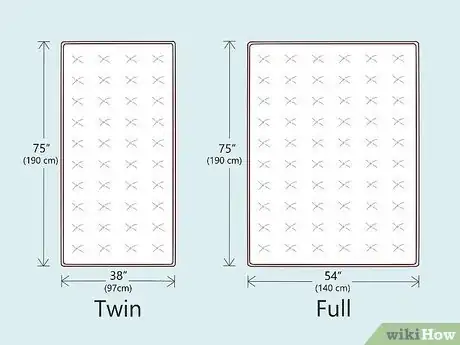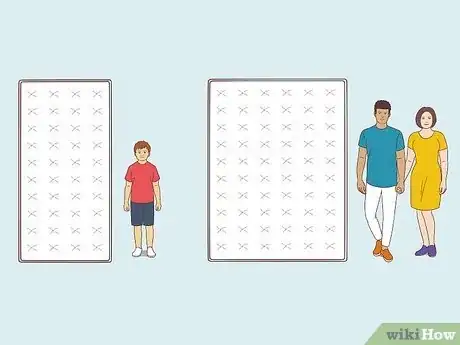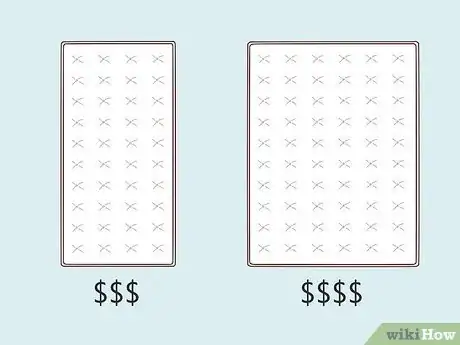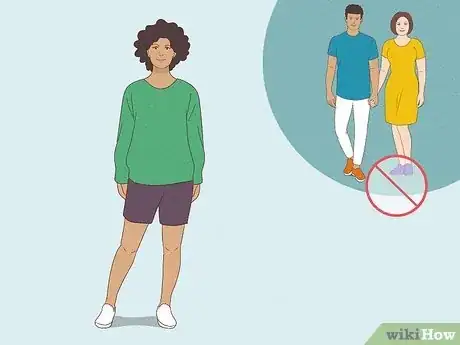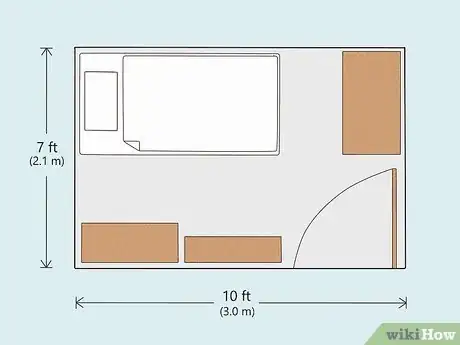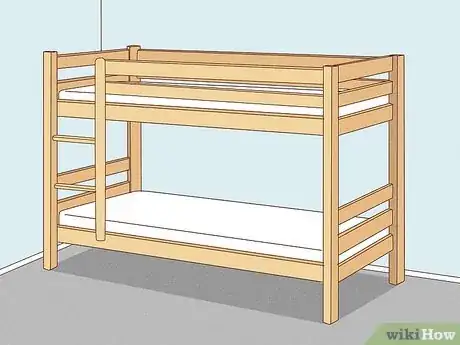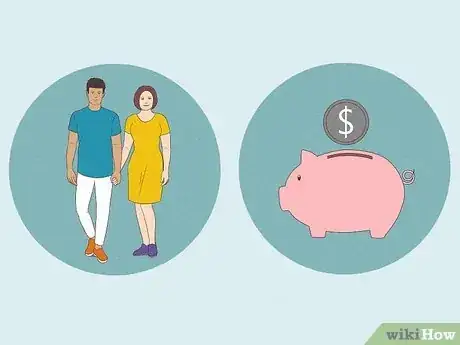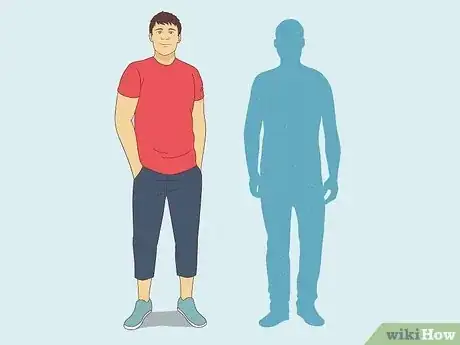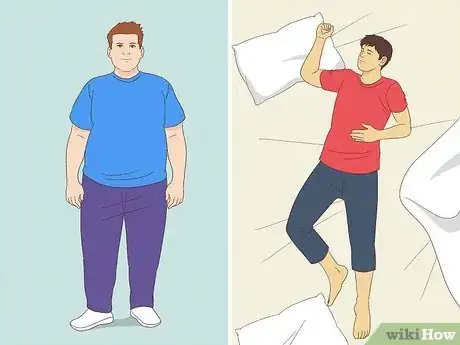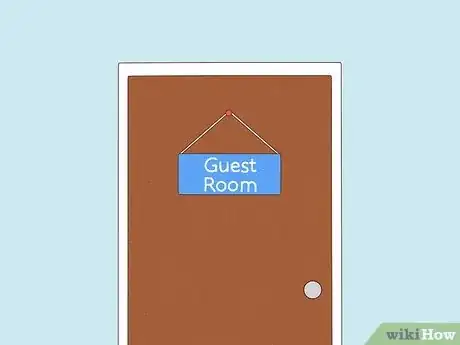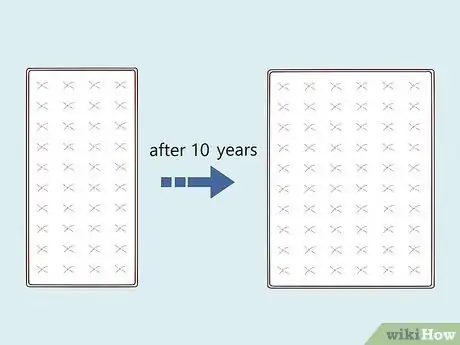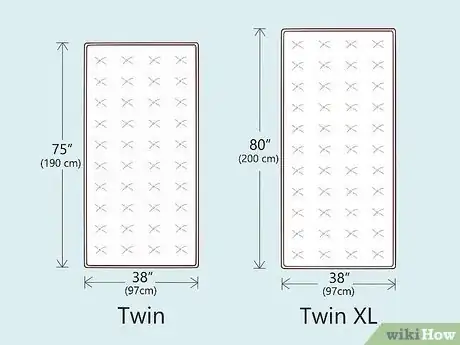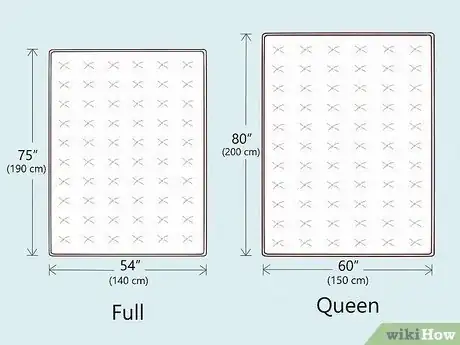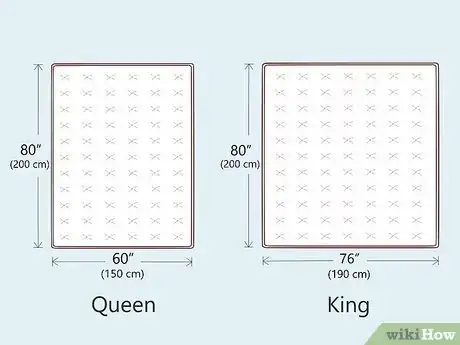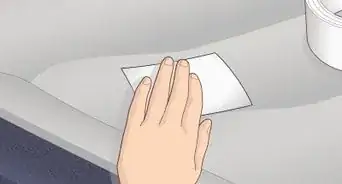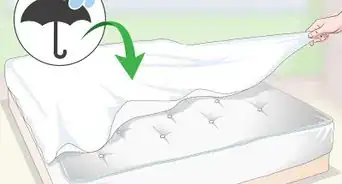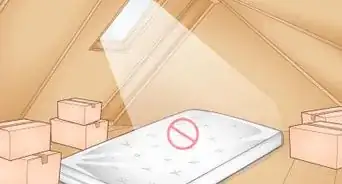This article was co-authored by wikiHow staff writer, Glenn Carreau. Glenn Carreau is a wikiHow Staff Writer, currently based in Los Angeles. With over four years of experience writing for several online publications, she has covered topics ranging from world history to the entertainment industry. Glenn graduated with honors from Columbia College Chicago, earning a B.A. in Interactive Arts and Media and a minor in Professional Writing. Today, Glenn continues to feed her lifelong love of learning while serving wikiHow's many readers.
Learn more...
Are you trying to recall the dimensions of twin and full beds? Maybe you're wondering which bed size would be best for you, a family member, or a guest room? When you make your decision, it’s important to consider factors like mattress size, room size, the number of people sleeping in the bed, and cost. Don’t worry: we're here to break down the differences and help you choose the best mattress size based on your needs. You’ll be channeling your inner Goldilocks in no time, testing out different mattresses until you find one that’s just right!
Things You Should Know
- The main difference between a twin mattress and a full mattress is their width; full-size beds are 1.5 feet (0.46 m) than twin beds.
- Twin beds are best suited to single sleepers like toddlers, kids, and teens. They don’t usually fit more than one person, but they’re compact and relatively cheap.
- Full beds are bigger than twins, ideal for sleeping a couple or a single sleeper who wants extra room. They cost more than twin beds but are cheaper than kings and queens.
Steps
When to Choose a Twin
-
1You’re shopping on a strict budget and need a cheaper mattress. When budget is a major factor, buying a twin-size mattress is usually much easier on your wallet than a full, with an average cost between $250 and $1000. The economical price point makes twin beds ideal for anyone looking to accommodate a single sleeper at a low cost.[3]
- This also applies to accessories like bed frames, sheets, pillows, and quilts. You’ll usually pay less for twin bed accessories because they come in smaller sizes than larger full bed items.
- Price is also something to consider if you think your new mattress will get worn out quickly. For example, if you’re getting a dorm room bed and you know you’ll probably throw the mattress away after a couple of years, spending a ton of money might not be wise.
-
2You only need to accommodate a single person with the bed. Twin mattresses are the only size mattress that really aren’t meant to be shared. Young kids can get away with sharing a twin bed if they need to, but overall, they’re called “single beds” for a reason. If you’re in the market for a mattress and you only plan for one person to sleep on it, then a twin mattress fits your criteria.[4]
- Two people sharing a twin mattress would have only 19 inches (48 cm) of sleeping space each, which is not nearly enough to comfortably sleep on for most people.
-
3You need to fit a mattress into a small bedroom space. Twin mattresses are the most compact standard-size mattress on the market (other than an actual crib mattress), so they’re the natural choice if you’re working with extremely limited space and there’s only a single sleeper using it. To be safe, measure your room before investing in any mattress, even a twin.[5]
- It’s recommended that you set up a twin mattress in a room that is at least 7 feet (2.1 m) by 10 feet (3.0 m) to fit the bed comfortably.
- When you choose a mattress, you’ll save roughly an extra 1.5 feet (0.46 m) of floor space if you pick a twin over a full. In a very small room, that makes a big difference.
- As you measure out your space, consider how the room is oriented and how much flexibility you’ll have when it comes to bed placement. If you’re locked into 1 or 2 spots for the bed, use a measuring tape to see which works better.
-
4You want to invest in a day bed, bunk bed, or dorm room bed. Twin mattresses are ideal as day beds because their shorter width means a few well-placed cushions can easily turn a twin into a seating area during the day. They’re great for dorm rooms because dorm space is usually limited. Finally, the majority of bunk bed frames are built for twin mattresses, so they’re the natural choice for a bunk bed.[6]
-
5You have a small to average-size body and don’t need a big bed. A small to average size child, teen, or adult can settle in quite nicely on a twin mattress. With 19.8 square feet (1.84 m2) of space on a twin mattress, there’s plenty of room for someone with a smaller body size to have everything they need to have a good night’s sleep.[7]
- If you don’t mind the width of a twin mattress but need a bit more length, choose a twin XL mattress instead.
- Keep in mind that not all adults can comfortably fit on a twin mattress. Some are simply tall or wide enough that the mattress feels too small to sleep on.
-
6You’re a peaceful sleeper and don’t move around much at night. Twin beds can be a bit uncomfortable for restless sleepers—people who tend to move or thrash around often in their sleep. Because twin mattresses are so small, there’s not a lot of room for movement. However, if you don’t move around much and sleep peacefully through the night, you’ll likely have no problem feeling cozy on a twin.[8]
When to Choose a Fulll
-
1You’re a couple looking to buy a new mattress on a budget. Full mattresses are more expensive than twins, but they’re also generally considered the smallest mattress size that can reasonably fit 2 people on it. This makes a full mattress the most economical choice for a couple! Expect to pay between $400 to $1500 for a full-size mattress.[9]
- Full mattresses are also still considered a budget-friendly choice because the costs for bed frames and bedding are less than all other larger 2-person mattress options.
- Depending on your sizes and sleep styles, a full might not be large enough for you as a couple. Test out a full mattress before buying, if possible, and consider a queen mattress if you end up disliking the full.
-
2You’re a single sleeper who wants the flexibility of a larger bed. If the full-size mattress will primarily be used by a single person (you), but you want the option to accommodate another sleeper when the need arises, consider investing in a full-size mattress. This can be especially helpful if you’re dating someone but don’t live together or you tend to share your bed with a friend or sibling from time to time.[10]
-
3You’re a large or active single sleeper. If you’re a large or active sleeper, a twin bed might not feel all that comfortable to sleep in because of the limited space. It can actually be disruptive when you don’t have enough room to flail and flop in your sleep! So, a full bed might be a better option because it offers that extra 1.5 feet (0.46 m) of width to support your entire body and give you space to move around.[11]
- The additional space in bed can also keep you from feeling like you’re about to fall out of bed all night long.
- Just remember that full-size mattresses are the same length as twins, so they won’t help you if you feel too tall for a twin. If height is an issue, look into a full XL mattress, which is longer.
- A 6 feet (1.8 m) tall sleeper would actually only have 3 inches (7.6 cm) of extra bed space if they stretched to full length on a twin or full mattress.
-
4You’re setting up a smaller apartment or guest room. Though it isn’t as compact as a twin mattress, a full is an excellent space-saving option when you also want a little extra room to roll around on the bed. If you’re looking to set up a guest room or a bedroom in an apartment with limited space and you don’t have the budget for a queen, a full-size mattress is a solid choice as it still sleeps up to 2 people.[12]
- Keep in mind that the recommended room size for a full mattress is at least 10 feet (3.0 m) by 12 feet (3.7 m). Any smaller, and it might feel a little cramped in the room!
-
5You’re a teenager or young adult upgrading from a twin mattress. Full mattresses are considered ideal for teens and young adults, especially if you’ve been using a twin mattress thus far in your life. Upgrading to a full mattress can be a refreshing change; it allows you to have a more mature sleeping setup, but it isn’t as hard on your (or your parents’) wallet as a queen or king bed would be.[13]
-
6You’re a single sleeper sharing the mattress with a pet most nights. As long as your pet isn’t a Great Dane (or some other large animal that’ll take up more than half of the bed), you’ll likely have just enough room on a full bed for them. Just don’t try to share the bed with more than 1 or 2 pets at a time; then, even a full-size bed might start to feel cramped.[14]
More Mattress Sizes
-
1Twin and full mattresses come in a longer XL version. Rather than buying a standard twin or full mattress, you can invest in an XL version of either mattress, which keeps the same width as a standard mattress but adds 5 inches (13 cm) to the length. A twin XL mattress is 38 inches (97 cm) wide and 80 inches (200 cm) long, and a full XL mattress measures 54 inches (140 cm) wide and 80 inches (200 cm) long.[15]
- Twin XL mattresses can cost between $300 and $1,200.
- XL mattresses are a popular choice for those who both have the room space to fit one and are tall enough to need the extra length on their mattress.
-
2Queen mattresses offer more room to stretch without being too big. A standard queen mattress measures 60 inches (150 cm) wide and 80 inches (200 cm) long, making them wider and longer than a standard full-size mattress. Queen beds are popular among single adults who want some extra wiggle room in their bed, but might not have enough bedroom space for a king bed.[16]
- Queen mattresses typically cost between $500 and $2,500.
- Couples can also fit comfortably on queen mattresses, though they won’t have as much personal space as they might on a bigger bed.
-
3King mattresses are the largest standard-size mattresses available. Measuring 76 inches (190 cm) wide and 80 inches (200 cm) long, a king mattress is the same length as a queen but 16 inches (41 cm) wider, making it ideal for couples who want plenty of personal space as they sleep. Kings take up the most space in a bedroom, but they can easily sleep 2 adults.[17]
- King mattresses are usually the most expensive type of mattress, ranging between $800 and $3,000.
- King mattresses are essentially the equivalent of pushing 2 twin XL mattresses side by side; doubling the length and width of a twin XL mattress equals a king mattress.
-
4California king mattresses are slightly narrower and longer than kings. California kings have the same overall area as a standard king, but they’re proportioned differently, measuring 72 inches (180 cm) wide and 84 inches (210 cm) long. That means couples who sleep in them might be a little closer together, but they’ll have extra space to stretch out vertically.[18]
- A California king mattress usually fall within a similar price range as the standard king, between $800 and $3,000.
References
- ↑ https://www.sleepfoundation.org/mattress-sizes
- ↑ https://www.tomorrowsleep.com/twin-vs-full
- ↑ https://www.sleepfoundation.org/mattress-sizes
- ↑ https://www.sleepfoundation.org/mattress-sizes
- ↑ https://www.sleepfoundation.org/mattress-sizes
- ↑ https://sleepopolis.com/guides/bed-size-dimensions/#:~:text=For%20single%20sle
- ↑ https://www.sleepfoundation.org/mattress-sizes
- ↑ https://sleepopolis.com/guides/twin-vs-twin-xl-mattress-guide/
- ↑ https://www.sleepfoundation.org/mattress-sizes
- ↑ https://www.usnews.com/360-reviews/sleep/mattress/mattress-sizes
- ↑ https://www.sleepfoundation.org/mattress-sizes
- ↑ https://sleepopolis.com/guides/bed-size-dimensions/
- ↑ https://sleepopolis.com/guides/bed-size-dimensions/
- ↑ https://sleepopolis.com/guides/twin-vs-twin-xl-mattress-guide/
- ↑ https://www.sleepfoundation.org/mattress-sizes
- ↑ https://www.sleepfoundation.org/mattress-sizes
- ↑ https://www.sleepfoundation.org/mattress-sizes
- ↑ https://www.sleepfoundation.org/mattress-sizes
